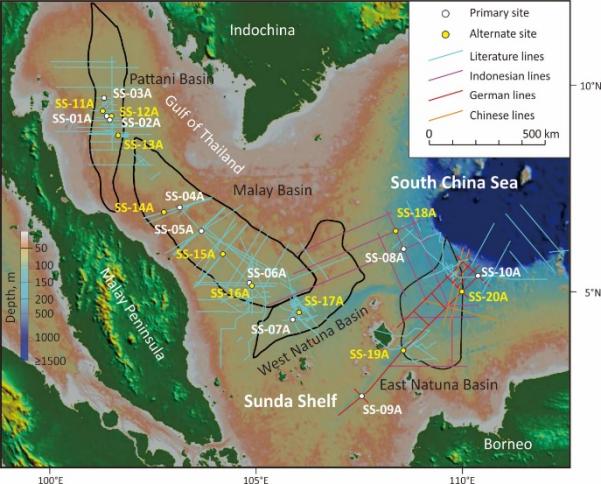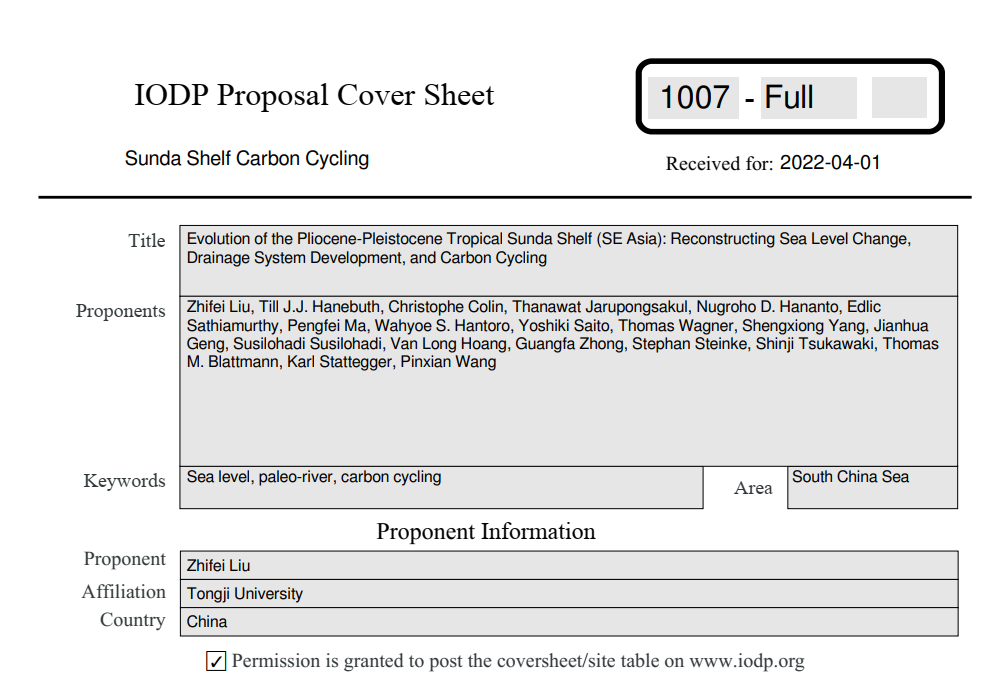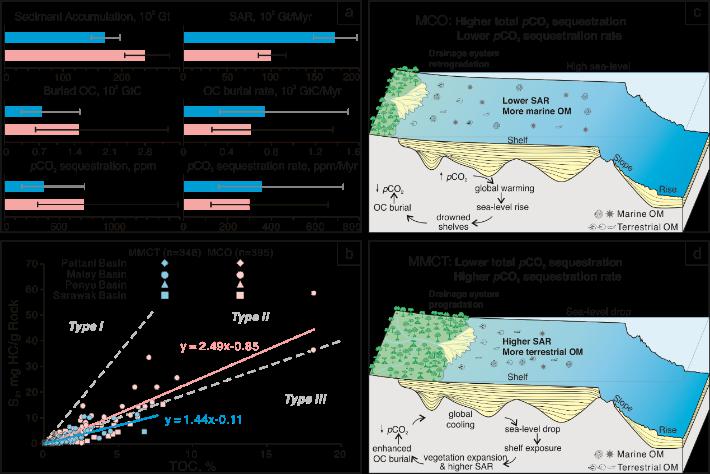三、巽他陆架大洋钻探建议书推进
Advancement of the Proposal for Sunda Shelf Drilling
作为低纬区面积最大的大陆架,巽他陆架有着极其平缓的坡度,并随全球海平面波动发生周期性的淹没和暴露,是“海洋大陆(Maritime Continent)”的重要组成部分。大量数据模拟和计算认为,海洋大陆的大规模海陆格局变迁会通过改变海洋和大气环流、硅酸盐岩和碳酸盐岩风化、有机碳埋藏等过程,影响中新世以来碳循环和水循环,进而调控全球气候演化。但是,上述一系列假说尚缺乏直接地质证据的检验。通过实施大洋钻探,获取巽他陆架中新世以来的连续海洋沉积记录,将是弥补这一不足的关键。为推进该项工作,我室深海沉积团队在2022年牵头组织了“巽他陆架大洋钻探建议书第三次国际研讨会”,联合国内外科学家正式提交了“巽他陆架大洋钻探建议书 (IODP Proposal 1007-Full) ”,并开展了一系列预研究。
巽他陆架大洋钻探建议书第三次国际研讨会成功召开
在前两次国际研讨会(2015、2016)的基础上,2022年3月线上召开了“巽他陆架大洋钻探建议书第三次国际研讨会”,会上,汪品先院士介绍了“巽他陆架大洋科学钻探建议书(IODP Proposal 907-Pre) ”的第一次提交和评审过程,并从古水系演化和碳循环角度综述了巽他陆架在全球气候环境变化研究中的重要意义。来自泰国、马来西亚、印度尼西亚等国的科学家分别就本国专属经济区内的Pattani、Malay和Natuna盆地的沉积-构造演化历史进行了详细介绍。最后,刘志飞和马鹏飞报告了建议书的科学目标、钻探策略、站位调查和规划安排等。
这一版建议书聚焦上新世以来全球加速变冷和北半球冰盖形成这一关键气候事件,拟通过10个主要站位和10个备选站位钻取巽他陆架多个盆地5 Ma以来的沉积记录,重建陆架海平面变化和流域演化,评估冰期陆架暴露后的碳封存效应,旨在检验“低纬海洋大陆暴露过程中的化学风化和有机碳埋藏控制了上新-更新世全球气候变化”这一假说。与会代表围绕上述报告进行了深入交流,高度肯定了建议书的科学目标和设计思路,并就后续资料补充、站位调查、钻探策略、数据提交等给出了建设性意见。

巽他陆架现今水深特征及钻探建议书(IODP Proposal 1007-Full)站位分布图
巽他陆架大洋钻探建议书正式提交
经过“第三次国际研讨会”的充分讨论,进一步完善后的巽他陆架大洋钻探建议书(IODP Proposal 1007-Full)于2022年4月初正式提交至IODP。建议书由刘志飞联合国内外19位科学家共同撰写(Liu et al., 2022),2022年6月经IODP科学评审工作组评审后结果为“Revise”。后续,国内外科学家将根据评审意见开展合作,补充地震剖面数据,系统修改建议书,并尽快完成重新提交。巽他陆架大洋钻探的顺利实施将提高“气候变化的低纬驱动”学说的国际影响力,继续扩大我国在南海大洋钻探和基础研究上的主导权,进而为中国共同引领2024年后国际大洋钻探计划奠定基础。

巽他陆架大洋钻探建议书(IODP Proposal 1007-Full)
巽他陆架大洋钻探预研究成果发表
在撰写和提交巽他陆架大洋钻探建议书的同时,马鹏飞、刘志飞等针对中中新世巽他陆架沉积体系的碳封存效应开展了系统研究(Ma et al., 2022)。该项工作收集了钻穿巽他陆架中中新世地层的367口油气井资料,利用地层厚度、总有机碳(Total organic carbon, TOC)数据计算了中新世气候适宜期(Miocene Climatic Optimum, MCO)和中中新世气候转型期(Middle Miocene Climate Transition, MMCT)巽他陆架沉积物堆积、有机碳埋藏、以及大气二氧化碳(pCO2)封存的总量和速率,同时结合裂解烃(Rock-Eval pyrolyzable hydrocarbon, S2)数据界定了不同阶段有机质类型。研究发现,中中新世巽他陆架埋藏的有机碳可能超过该阶段全球有机碳净埋藏的10%。其中,MCO阶段有机碳埋藏总量较大,但MMCT阶段埋藏速率更高;MMCT阶段沉积体系碳封存加速,有机质从海源主导向陆源主导转变,沉积堆积速率加快,三者同时发生,指示了MMCT时期陆地碳库的扩张和在巽他陆架区域的快速埋藏。陆架有机碳埋藏在MCO和MMCT阶段,可能分别通过负、正反馈机制,发挥调控大气pCO2变化的重要作用。即便假设潜在的火山排气强度在MMCT没有明显减弱,巽他陆架加速的碳封存也可以贡献该阶段至少1/6的pCO2减少量。

巽他陆架中中新世有机碳埋藏模式图
主要参考文献:
Liu, Z., Hanebuth, T. J., Colin, C., Jarupongsakul, T., Hananto, N., Sathiamurthy, E., Ma, P., Hantoro, W. S., Saito, Y., Wagner, T., Yang, S., Geng, J., Susilohadi, S., Hoang, V., Zhong, G., Steinke, S., Tsukawaki, S., Blattmann, T. M., Stattegger, K., and Wang, P., 2022, IODP Proposal 1007-Full: Evolution of the Pliocene-Pleistocene Tropical Sunda Shelf (SE Asia): Reconstructing Sea Level Change, Drainage System Development, and Carbon Cycling
Ma, P., Liu, Z., Jiang, M., Cheng, H., Zhang, L., and Cai, D., 2022, Carbon Sequestration of the Middle Miocene Sunda Shelf Facilitated Global Climate Change. Geophysical Research Letters, 49(21): e2022GL100638.
As a critical part of the Maritime Continent, the Sunda shelf is the most extensive tropical shelf across the world. It is characterized by extremely gentle gradient and has been confirmed to submerge and expose periodically in response to global sea level fluctuations since the earliest Miocene. Previous studies conducted with data compilations and model simulations suggested that large-scale land-sea reorganization of the Maritime Continent would impact global climate change over the Neogene by affecting various processes linked with water and carbon cycles such as ocean circulation, moisture transport, silicate-carbonate weathering, and photosynthetic carbon fixation. However, these hypotheses have not been tested by direct geological evidence. The implementation of scientific drilling to recover continuous marine sedimentary records of the Sunda shelf will be the key to make up for this shortcoming.
To promote the scientific drilling on Sunda Shelf, the Deep-sea Sedimentation Group, led by Prof. Zhifei Liu, has conducted substantial efforts in 2022. The 3rd International Workshop on the Sunda Shelf Drilling was organized online in March to develop the scientific ideas and discuss the draft proposal. The refined proposal entitled “Evolution of the Pliocene-Pleistocene Tropical Sunda Shelf (SE Asia): Reconstructing Sea Level Change, Drainage System Development, and Carbon Cycling” (IODP Proposal 1007- Full, Liu et al., 2022) was formally submitted in April. This proposal has been reviewed by the IODP Science Evaluation Panel and is in revision now. Moreover, we also carried out a study focusing on carbon sequestration of the Sunda Shelf and found that the accelerated organic matter burial of the shelf during the Middle Miocene Climate Transition may contribute at least 1/6 of the global atmospheric CO2 reduction (Ma et al., 2022).

